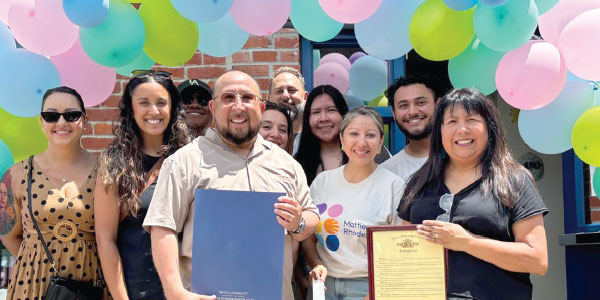
We Speak Spanish in America
MIAMI — The Latin American country closest to the United States is Miami, or so the old joke goes. Indeed, I can go entire days here without speaking English. And while the number of Spanish speakers in this country is steadily increasing, attacks against those who prefer to speak a language other than English are becoming more visible.
In 2006, there were 31 million Spanish speakers in the United States, according to data from the Pew Research Center; that number had increased to 37 million by 2015. Additionally, 73% of Latinos speak Spanish at home, and this figure is likely to keep increasing as the Latino community continues to grow. If we take into account all the people who communicate at least partially in Spanish, it’s possible that Mexico might be the only country in the world with more Spanish speakers than the United States.
This means that Spanish is spoken all over America, in every part of America; even in Montana. Unfortunately, not everyone is aware of this, including an immigration agent who recently stopped and questioned two U.S. citizens, Ana Suda and Mimi Hernández, at a store in Havre, Montana, because he heard them speaking Spanish. When they complained that this was discrimination, the agent denied it. “It’s the fact that it has to do with you guys speaking Spanish in the store in a state where it’s predominantly English-speaking,” he said.
A couple of weeks ago in New York, a lawyer was recorded criticizing some restaurant employees because they were speaking Spanish. On the video, he threatened to call Immigration and Customs Enforcement, saying he suspected that undocumented immigrants might be working there. A few days later he apologized, after his rant had gone viral on social media.
While I was filming the documentary “Hate Rising,” I interviewed Asma Jama in Minneapolis. She is a Somali-born American citizen who in 2015 had a beer mug smashed against her face by another woman in a restaurant because she had been speaking Swahili, leaving her soaked in blood from all the glass cuts.
Intolerance against those who speak a language that is not English has some pretty obvious explanations:
Racism; fear of those who are different; anxiety connected to the demographic changes taking place in this country. Additionally, President Trump has contributed significantly to anti-immigrant sentiment. His frequent attacks on foreigners are mimicked by his social media followers. Can we be surprised that, according to the Southern Poverty Law Center, there was a rise in hate crimes in this country in 2016?
America is the only country I can think of where there are people who think that speaking only one language is preferable to speaking more. “Speak American,” is a predictable comment whenever I write something in Spanish on social media. But while many see a connection between being an American and speaking only English, the fact is that English is not the official language of the United States. There is no official language in this country. After all, we all dance to the rhythm of “Despacito.”
Yes, English is the language of power, and English unites us in this country. But that doesn’t mean that we should refrain from speaking different languages here.
We should remember that the United States is on its way to becoming a country of minorities. By 2044, the Census has predicted that everybody — Latinos, whites, African-Americans, Asians, Native Americans — will belong to a minority. And the number of foreigners will continue to grow, which means that millions of people will be able to speak a language other than English. This shouldn’t be a surprise in a multiethnic society like ours. But, sadly, being able to speak Spanish in the Trump era has become dangerous.
Whether we like it or not, America is an example for the rest of the world. The only way that our diverse society can survive is through tolerance, inclusivity and respect for our cultural differences.
This is crystal clear in Miami, where I mostly communicate in Spanish. Today, for instance, I read the papers, went to work, went to the supermarket, made some calls, sent a bunch of texts and emails, had lunch and dinner in good company and wrote the first draft of this column all without using a single word of English.
(Jorge Ramos, an Emmy Award-winning journalist, is a news anchor on Univision.)
_____________________________________________________________________________________
En Estados Unidos Se Habla Español
MIAMI — Aquí en “Mayami, Florida”, hay días completos en que no tengo que hablar una sola palabra de inglés. Claro, la broma es que Miami es el país latinoamericano más cercano a Estados Unidos. La realidad es que cada vez hay más personas que hablan español en Estados Unidos. Pero también es cierto que son más visibles los ataques contra aquellos que prefieren comunicarse en un idioma distinto al inglés.
En el 2006 había 31 millones de personas que hablaban español en Estados Unidos, y eso aumentó a 37 millones en el 2015, según el Pew Research Center. Siete de cada 10 Latinos (73%) hablamos español en casa. Esas cifras seguirán aumentando debido al enorme crecimiento demográfico de la comunidad latina. Y si sumamos a todos los que se comunican parcialmente en español, podemos concluir que sólo en México hay más hispanoparlantes que en Estados Unidos.
Esto lo que quiere decir es que en todos los rincones de Estados Unidos se habla español — hasta en Montana. Pero eso aparentemente no lo sabía un agente que detuvo hace poco a dos ciudadanas estadounidenses — Ana Suda y Mimi Hernández — en una tienda de la población de Havre, Montana, por hablar español. Ellas, con razón, se quejaron de discriminación. Pero el agente lo negó y les dijo que fueron detenidas, “porque ustedes estaban hablando español en un estado donde se habla inglés predominantemente”.
En Nueva York un abogado fue grabado recientemente mientras criticaba a los empleados de un restaurante por hablar español. Luego los amenazó con llamar al servicio de inmigración bajo la sospecha de que ahí trabajaban indocumentados. Días después, el abogado se disculpó, pero su ataque a hispanoparlantes se hizo viral en las redes sociales.
Mientras filmaba el documental “HateRising”, entrevisté en Minneapolis a Asma Jama, una ciudadana estadounidense de origen somalí, a quien una mujer le estrelló un vaso de cerveza en la cara en 2015 por el simple hecho de estar hablando swahili en un restaurante. Su cara quedó totalmente ensangrentada por los pedazos de vidrio.
Esta intolerancia hacia los que hablan un idioma distinto al inglés tiene claras explicaciones: racismo, miedo a los que son distintos y ansiedad por los rápidos cambios demográficos que se están viviendo en Estados Unidos. El Presidente Donald Trump ha contribuido enormemente a este sentimiento antiinmigrante. Sus frecuentes ataques a los extranjeros son repetidos (y superados) por sus seguidores en las redes sociales. En el 2016 hubo un aumento en los crímenes de odio en el país, según el Southern Poverty Law Center.
Estados Unidos es el único país que conozco donde hay gente que cree que hablar un idioma es mejor que dos. “Speak American” me reclaman a veces en las redes sociales cuando escribo en español. Es muy significativo que algunos identifiquen el hablar inglés con el hecho de ser estadounidense. Pero, contrario a lo que muchos creen, el inglés no es el idioma oficial de Estados Unidos. No hay idioma oficial, y aquí todos bailamos “Despacito”.
Por supuesto, el inglés es el lenguaje del poder y el que nos une a todos en Estados Unidos. Pero eso no evita que norteamericanos y extranjeros, por igual, prefieran comunicarse en decenas de idiomas distintos.
Estados Unidos está en camino de convertirse en un país de minorías. En el 2044 todos — latinos, blancos, afroamericanos, asiáticos y nativos — seremos minorías. Además, el número de extranjeros seguirá aumentando, y eso significa que millones de personas hablarán un idioma distinto al inglés. Esto no debería sorprendernos en una sociedad multiétnica como la estadounidense. Pero hablar español en la era de Trump puede convertirse en un peligro.
Estados Unidos, lo quiera o no, es una representación global del planeta. Y la única manera de sobrevivir en una sociedad tan diversa es con tolerancia, con políticas incluyentes y respetando nuestras diferencias culturales. Esta es una nación de muchos acentos y colores.
Y eso está muy claro en Miami, donde la mayor parte de mi vida sigue siendo en español. Hoy leí los periódicos, fui al trabajo y al supermercado, hice varias llamadas, envié un montón de textos y correos electrónicos, comí y cené acompañado, y escribí esta columna todo sin una sola palabra en inglés.
(Jorge Ramos, periodista ganador del Emmy, es el principal director de noticias de Univision Network. )










